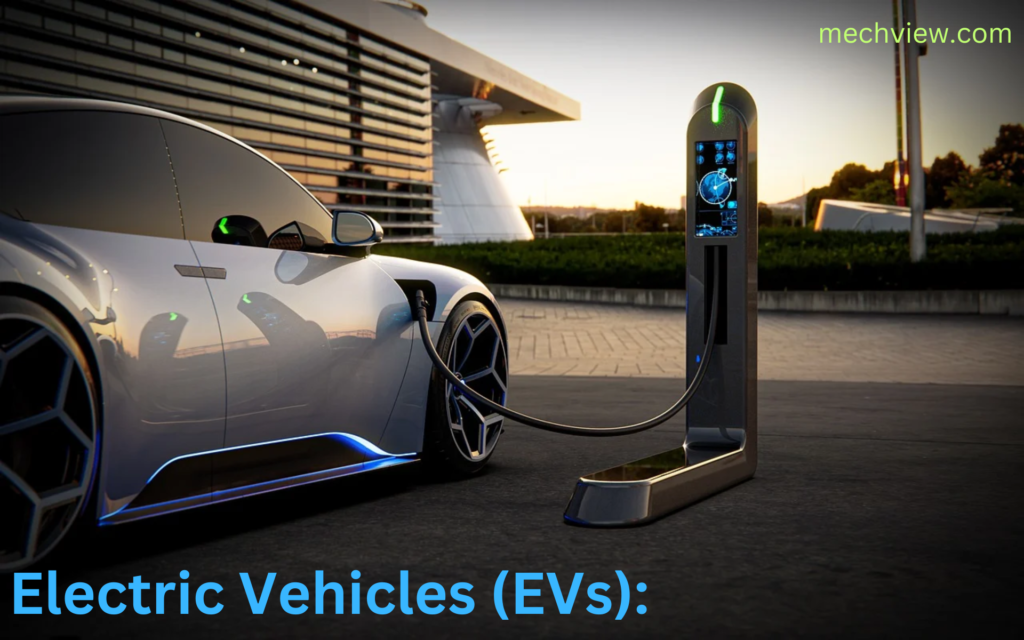Electric and hybrid vehicles represent a significant shift in the automotive industry towards cleaner and more sustainable transportation options. Understanding how these vehicles work, their components, and their pros and cons is crucial for making informed decisions about their adoption and usage.
Electric Vehicles (EVs):
Electric vehicles (EVs) are automobiles that are powered by electric motors and use rechargeable batteries or other energy storage systems for propulsion. These vehicles do not rely on traditional internal combustion engines fueled by gasoline or diesel. Instead, they operate by converting electrical energy stored in the battery pack into mechanical energy to drive the vehicle. EVs can be charged from external power sources such as charging stations, home outlets, or renewable energy sources like solar panels.

The key components of electric vehicles include:
- Battery Pack: Stores electrical energy and provides power to the electric motor.
- Electric Motor: Converts electrical energy from the battery into mechanical energy for propulsion.
- Charger: Used to recharge the battery’s energy by connecting to an external power source.
Working Mechanism of EVs: When an EV is in operation, the electric motor draws power from the battery pack to drive the wheels, providing propulsion. Unlike internal combustion engines, EVs produce zero tailpipe emissions, making them environmentally friendly. The energy efficiency of electric motors is also higher than traditional engines, leading to lower energy consumption per mile.
Advantages of Electric Vehicles:
- Zero Emissions: EVs contribute to reducing air pollution and greenhouse gas emissions, supporting efforts to combat climate change.
- Energy Efficiency: Electric motors are more efficient than internal combustion engines, resulting in lower energy consumption and reduced dependence on fossil fuels.
- Lower Operating Costs: EVs have fewer moving parts and require less maintenance, leading to potential cost savings over time.
- Quiet and Smooth Operation: Electric motors operate quietly and provide smooth acceleration, enhancing the driving experience.
Disadvantages of Electric Vehicles:
- Limited Range: Most EVs have a limited driving range per charge, which can be a concern for long-distance travel.
- Charging Infrastructure: The availability of charging stations is not as widespread as gas stations, leading to concerns about range anxiety.
- Charging Time: It takes longer to recharge an EV compared to refueling a gasoline vehicle, which may inconvenience some drivers.
- Upfront Cost: EVs generally have a higher upfront cost due to the cost of battery technology, although this is decreasing with advancements.
Hybrid Vehicles:
Hybrid vehicles are automobiles that utilize a combination of two or more power sources for propulsion, typically including an internal combustion engine (usually gasoline or diesel) and an electric motor powered by a battery pack or other energy storage system.
OR
A hybrid vehicle is a car that combines two types of power sources to run: an internal combustion engine, like those found in regular cars, and an electric motor that is powered by a battery. This combination allows hybrid vehicles to use less fuel and produce fewer emissions compared to traditional gasoline-powered cars.
The main types of hybrid vehicles are:
- Parallel Hybrids: In parallel hybrids, both the internal combustion engine and the electric motor can directly power the vehicle, either independently or together. The system seamlessly switches between the two power sources based on driving conditions and energy demands.
- Series Hybrids: Series hybrids feature an internal combustion engine that charges the battery pack, while the electric motor solely drives the wheels. The engine does not directly power the wheels, but it operates to generate electricity for the electric motor, extending the vehicle’s range.
- Plug-in Hybrids (PHEVs): Plug-in hybrids are equipped with a larger battery pack that can be charged from an external power source, such as a charging station or home outlet. This allows PHEVs to operate in electric-only mode for a certain distance before switching to the internal combustion engine.
Key components of hybrid vehicles include:
- Engine: Provides power to the wheels and charges the battery in some hybrid configurations.
- Electric Motor: Assists the engine during acceleration and operates independently in electric-only mode in certain hybrids.
- Battery Pack: Stores electrical energy for use by the electric motor and can be charged from external sources in PHEVs.
- Regenerative Braking System: Captures energy during braking and converts it into electricity to recharge the battery, improving overall efficiency.
Advantages of Hybrid Vehicles:
- Improved Fuel Efficiency: Hybrids use a combination of gasoline/diesel and electric power, resulting in better mileage and reduced fuel consumption.
- Reduced Emissions: By using electric power part of the time, hybrids produce lower emissions compared to traditional vehicles.
- Regenerative Braking: This feature helps extend the lifespan of brake components and improves overall efficiency.
Disadvantages of Hybrid Vehicles:
- Cost: Hybrids may have a higher upfront cost due to the dual powertrain system and battery technology.
- Complexity: The integration of multiple power sources and systems can make hybrids more complex to manufacture and maintain.
“MechView: Unveiling Mechanical Engineering, Simply Explained!”